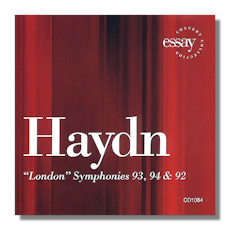
The Internet's Premier Classical Music Source
Related Links
- F.J. Haydn Reviews
- Latest Reviews
- More Reviews
-
By Composer
-
Collections
DVD & Blu-ray
Books
Concert Reviews
Articles/Interviews
Software
Audio
Search Amazon
Recommended Links
Site News
 CD Review
CD Review
Franz Joseph Haydn

"London" Symphonies
- Symphony #93 in D Major
- Symphony #94 "Surprise" in G Major
- Symphony #92 "Oxford" in G Major
Philharmonia Virtuosi/Richard Kapp
Essay CD1084 70.03
Summary for the Busy Executive: Fun.
I suppose I shouldn't say this in public, but, with only four exceptions, I prefer Haydn's symphonies to Mozart's. To me, it comes down to a difference between a steak and a bowl of gumbo. Mozart's symphonies strike me as solid, even slightly heavy – great works, many of them, to be sure, but in many ways predictable and not a whole lot of fun. On the other hand, Haydn's bubble with wit, surprise, caprice, and sometimes downright loopiness. If Haydn doesn't soar as high as Mozart, he also doesn't bore me as much as Mozart.
The "London" symphonies, as they've come to be called, were all performed during Haydn's highly successful visits to England. Not all of them were written for that trip. Indeed, Symphony #92 had been written at least a couple of years before Haydn even knew he was going. England, known from the death of Purcell to the appearance of Elgar as "the land without music," was actually, then as now, mad for music. London attracted the finest virtuosos, maintained orchestras of a size and level unknown even in Vienna. The impresario Johann Peter Salomon, a native German resident in London, who arranged for Haydn's concerts, had advised the composer to aim for effect rather than for refinement, pointing out the differences between the aristocratic audience in Vienna and the bourgeois public in England. Haydn's idiom has become so much a part of us that we tend to take it for granted. It's difficult for modern, post-Stravinskian ears to hear the audacity of these symphonies. We hear Haydn today and usually think of powdered wigs. Haydn's first audiences often considered him a "sauvage."
For me, one of the great glories of Haydn is the latitude he gives to interpreters. I don't have one favorite Haydn conductor, but several favorites. I like Doráti's earthiness as much as Szell's refinement. Szell, among other things, gives me the surprise (and the lightness) of Haydn's orchestrations, mostly as lagniappe to superb playing from the Cleveland Orchestra, and shows me Haydn as a figure of his time. Kapp gives me Haydn as herald of things to come, emphasizing his links to his star pupils, Mozart and Beethoven. Kapp's orchestra plays rougher than Szell, but also with higher spirits. The opening to the slow movement of #93, for string quartet, emphasizes Haydn's daring, this time on the side of delicacy. Kapp's quartet sets the tone for a huggable intimacy to the entire movement. On the other edge during the same movement, Kapp allows the bassoon to punctuate a "melting" cadence with a belch.
The "Surprise," #94, probably the best-known of the entire set of "London" symphonies, receives a fine, friendly performance. In the main allegro of the first movement, Kapp lets us hear intimations of the Beethovenian scherzo. In the second movement, Kapp throws what sounds like a literal kitchen sink into the famous surprise. This may put some listeners off, but I root for vulgarity. Kapp's rendering strikes me as thoroughly in keeping with Haydn's rough whimsy. The end of the movement is pure magic.
The "Oxford," #92, has been overshadowed by the "Surpise" – a shame, since to me it seems more characteristic of Haydn's personality, with a finer first movement. That movement, like late Beethoven, flirts with falling-apart. The music teeters on the edge of a constant stopping and starting, with ideas that shouldn't go together but, miraculously, do. The slow movement seems a cross between the Mozart and the Beethoven adagio, with some tasty, near-instantaneous modulations to Novo Sibersk and back again. Despite the clever touches – quite a few of them – a Romantic yearning shines through the wit. With the minuet, we glimpse the daffy Haydn, who leads us on a surreal dance. We don't land on the wrong foot, but now and then we glance down just to make sure. It's a movement of quick, unsettling cuts. Proportions seem off, as if the band has either added or omitted a measure here and there. Odd disjunctions break the flow of musical thought. The finale, a fleet rondo, bounces between extremes of lightness and heroic heft. Kapp gives his best performance of the disc.
The recording comes from a live concert, and one hears occasionally raggedness or smooshy attack, mainly from the strings, usually in faster rhythms. You can also hear pages turning, but the audience is remarkably silent. If not for the final applause, you wouldn't know anybody was there. Kapp and his Philharmonia do least well with Haydn's "show-off" contrapuntal passages – a bit heavy, for my taste (I kept longing for Szell) – but there aren't all that many in Haydn anyway. In all, this is Haydn you can have a beer with.
Copyright © 2008, Steve Schwartz




















